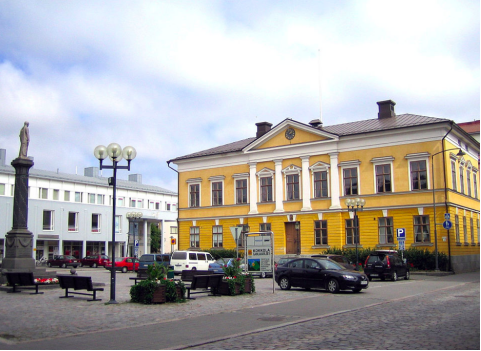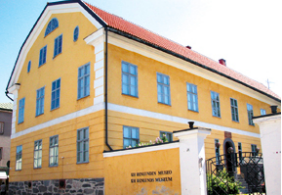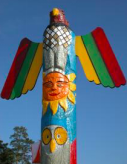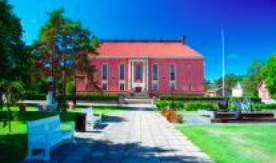Kokkola 作者: 来源: 发布时间:2021-10-15
一、所属省或是州,具体位置,人口,面积
Kokkola is a town and municipality of Finland. The town is located in the Central Ostrobothnia region. The town has a population of 47,734 (31 July 2020) and covers an area of 2,730.80 square kilometres (1,054.37 sq mi) of which 1,286.61 km2 (496.76 sq mi) is water. The population density is 33.05 inhabitants per square kilometre (85.6/sq mi). Neighbour municipalities are Halsua, Kalajoki, Kannus, Kaustinen, Kronoby, Lestijärvi, Larsmo and Toholampi. The municipality is bilingual with 84.2% being Finnish and 13.9% Swedish speakers. Kokkola will celebrate its 400th anniversary in 2020.

二、自然地理
1.地理条件
Kokkola is the capital of the Central Ostrobothnia region, it is located on the coast of Gulf of Bothnia, the northernmost part of the Baltic Sea. The next larger cities are Vaasa is 121 kilometres (75 miles) southwest, and Oulu is 198 kilometres (123 miles) northeast. The distance to the capital Helsinki is 483 kilometres (300 miles) to the south. Neighbouring cities and municipals are Kalajoki in the northern east, Kannus and Toholampi in the east, Halsua and Kaustinen in the southern east, Kronoby in the south and Larsmo in the southern west.
The landscape of the region around Kokkola is flat, typical for the area of Ostrobothnia, with numerous river courses flowing through the land. The biggest river in the area is Perhonjoki, which flows into Gulf of Bothnia, north of Kokkola. The annual post-glacial rebound at Kokkola is 8.8 mm. Thus large areas of present-day Kokkola were under water when the town was founded.
Kokkola marks the northernmost settlement area of the Swedish-speaking population of Finland (Finland-Swedes) on the western coast of Finland. 84.0% of the inhabitants of Kokkola speak Finnish as their mother tongue, 12.6% Swedish. The remaining 3.4% speak Estonian, Russian or other mother tongues. Kokkola is an official bilingual city with Finnish as the language of the majority and Swedish as the language of the minority. The approximately 6,020 Swedish-speaking inhabitants of Kokkola are spread unevenly around Kokkola: Whereas the centre of the city is bilingual, the majority of the villages around Kokkola mostly speak Swedish. The districts which were consolidated in 2009 are, however, pure Finnish-speaking areas.
The Kokkola area has the most natural and extensive dune sands in Finland, lush river valleys and extensive bay and oasis meadows. The diversity of nature is emphasized by the extent of the various nature reserves, a total of about 290 hectares. The flora and fauna meet north and south. The fauna includes all the great carnivores of our country down to the wolf and the wild deer. The highest points of Kokkola in Suomenselä rise to more than 180 meters above sea level.
2.交通情况
Kokkola is located on the coast of Gulf of Bothnia, and the coastal European route E8 (Finnish highway 8) goes through, connecting Oulu and Turku via Vaasa. Finnish highway 28 begins from Kokkola and runs to Kajaani. Finnish highway 13 begins from Kokkola and runs through Finland into the Nuijamaaborder to Russia crossing via Jyväskylä and Mikkeli. The scenic '7 Bridges Archipelago Road' (road 749) runs along the coast between Kokkola and Jakobstad (Finnish: Pietarsaari). Kokkola-Pietarsaari Airport is situated 22 kilometres (14 mi) from Kokkola in Kronoby. The Kokkola railway station is a stop along Line 7, with service between Helsinki and Kemijärvi via Tampere and Seinäjoki, where the fast Pendolino bullet train operates. There is no passenger ferry traffic from Kokkola.
The city's port is located in the Ykspihlaja district and is one of the busiest ports in Finland. Kokkola has good rail connections both to the north - in the direction of Ylivieska and Oulu - and to the south, via Seinäjoki and Tampere to Helsinki. Kokkola-Pietarsaari Airport is located 19 km southeast of Kokkola in the municipality of Kruunupyy.
三、经济发展和规模
Kokkola is the capital and biggest city in the region of Central Ostrobothnia. The chemical industry is a major employer. An industrial area and a port is located in Ykspihlaja. OMG has a cobaltplant. The Freeport/Umicore refinery is the only large cobalt refinery outside China. Boliden has a zinc plant. Kemira, a chemical conglomerate, built an industrial park that is now divided among several corporations. In addition, industries represented in the town include metalworking, casting, textiles, plastics, food and carpentry. Largest employers are as follows (2011):
The city of Kokkola approx. 2.350
Central Ostrobothnian Joint Municipal Authority for Social and Health Services (Soite) 2.500
Boliden Kokkola Oy (zinc) 500
Umicore (was Freeport Cobalt Oy until 2019) (cobalt) 420
KPO group (retail) 400
Halpa-Halli (retail) 300
CABB Oy (fine chemicals) 200
The port of Kokkola is located in Ykspihlaja, approximately 5 km (3 mi) from the city center, and it is one of the busiest ports in Finland. Oil, ore and limestone are imported, refined products and timber are exported, and iron ore is transited.
The City Council exercises the highest decision-making power in the City of Kokkola. The Council is responsible for the city’s activities and finances. It decides on the city’s strategic policies. The City Council must determine the financial principles and the principles for funding as well as approve the annual budget. The City Board is responsible for the administration and financial management of the city, and promotes the economic efficiency of activities and common interests in the city. The City Board manages the City Group and it is responsible for the preparation and execution of local council decisions and for oversight of their legality. The City Board manages the activities in committees and departments as well as monitors and oversees the extent to which the set targets have been achieved. The Mayor is responsible for the strategic management of the City Group. The Mayor manages, supervises and develops the city’s administration and economy. The Mayor supervises the preparatory work on matters considered by the City Board and acts as the presenting officer for the City Board.
https://www.kokkola.fi/hallinto/en_GB/etusivu/
四、产业特点/重点项目
Kokkola has a diverse industry, especially the chemical industry, including Freeport Cobalt Oy's cobalt plant and Boliden Kokkola Oy's zinc plant. In addition, the city has companies that produce metal products, boats, food and wood, as well as a wealth of industrial services, such as design and transportation companies. There are dozens of active cultural organisations in Kokkola, offering a wide array of cultural hobbies to people of all ages and interests. You can find out more about the organisations in Kokkola from our register of organisations.
The village of Lohtaja in the area of the former municipality of Lohtaja on Vattajanniemi is home to one of the largest integrated sandy areas in the Gulf of Bothnia, which has been presented as a national park. There is the Defense Forces Lohtaja shooting range. The weapons school operated in the city from 1973 until 1996. The depot area Keskusvarikko 8 has also operated in Kokkola.
The Kokkola municipal board for education and culture awards project and rent subsidies to organisations, cultural associations, individual artists or group of artists. Subsidies are applied for using a specific subsidy form that must be returned with the necessary attachments to the Kokkola municipal Cultural services.
Apart from the city of Kokkola, cultural activities are also supported by the regional arts council and private foundations. You will find further information about the different possibilities of receiving support for cultural activities from the links on the right. The city organization of Kokkola consists of corporate administration and corporate services, service areas and public utilities.
The corporate administration is responsible for the central administration, economy and it-services, human resources, business and city development. The service areas are technical services, educational and cultural services, the regional rescue department and the environmental health services. The city owns one independent public utility, Kokkolan Vesi (water management). The city’s commercial enterprises include 42 subsidiary companies, 17 associated companies and 7 federations of municipalities.
The diversified Kokkola city group includes the department of education and culture, urban environment, corporate administration and corporate services, and city utilities and affiliated companies. The city employs close to 2,300 employees. View and apply for openings at the City of Kokkola via the online service Kuntarekry.fi. Openings are also advertised e.g. on the Kokkola.fi website and in newspapers. Information about openings at the City of Kokkola is also available on the Ministry of Economic Affairs and Employment TE-services website and at the local TE Office in Kokkola (Pohjanmaan TE-toimisto).
https://www.kuntarekry.fi
https://www.kokkola.fi/palvelut/kulttuuripalvelut/avustukset/en_GB/avustukset/
http://www.te-palvelut.fi/te/en/index.html
五、风景名胜,景点( attractions)
1. K.H. Renlund museum

K.H.Renlund Museum in the city centre offers free of charge experiences of art and town history. Welcome to Kokkola to enjoy art and history! This rich cultural heritage of Kokkola is displayed in the K.H.Renlund Museum. Alongside exhibitions, the museum offers an extensive range of educational programmes for visitors of all ages.We celebrate the 400 years of Kokkola by voicing personal stories in a historical setting. Business and culture were in bloom in the city of tar merchants, ship-owners and craftsmen. The city fostered pioneers and bold entrepreneurs of their time, among them experts, builders and defenders, as well as observers and hedonists. We give them a voice to tell their stories about life in Kokkola over centuries.
The courtyard of the Museum Quarter is an oasis during the summer, a pleasant place where you can sit and enjoy refreshments in historical surroundings before or after a tour of the museum. A wide range of exhibitions can be admired at the Roos House, the Pedagogy, the Lassander House and the Exhibition Hall. Visits to the Drake House and to see Leo Torppa's Camera Collection can be arranged by appointment. Karl Herman Renlund (1850-1908) donated his large art collection to the town of Kokkola. The collection of about 40 works from the Golden Age of Finnish Art can be seen at the Roos House (1813), which also houses some of the museum's temporary exhibitions and the museum shop. Photographer Leo Torppa's camera collection is on display in the salt storehouse. The Museum quarter: The Pedagogy, a schoolhouse built in 1696, is the oldest non-ecclesiastical wooden building in an urban setting in Finland. The Lassander House offers a glimpse into ban setting in Finland. The Lassander House (1748) offers a glimpse into a merchant’s home in the 18th century. In the Exhibition Hall Modern folk art and international Outsider art from private and the ITE Contemporary Folk Art Museum collections are currently displayed in cooperation with the Union for Rural Culture and Education
https://www.kokkola.fi/visitkokkola/nae_and_koe/en_GB/museot/
2.Visual Arts and Handicrafts

Veikko Vionoja’s summer home is located in Ullava. Taide-Vionoja, maintained by a private foundation, is open during the summer, when the master artist’s works are on view in authentic Vionoja surroundings. Suntin Helmi -gallery (Pormestarinkatu 2) is maintained by the local artist organisation.
Temporary exhibitions are also regularly housed in the vestibule of the Kokkola City Hall (Kauppatori 5) and at the City Library (Isokatu 3). Visual arts may be studied at Kokkolan seudun opisto and the Kokkola Art School for Children. The links on the right take you to the appropriate websites. The hobby artists of Kokkola have organised themselves as the Kokkola Visual Arts Association. You will find contact information in the Kokkola register of organisations
The Central Ostrobothnia arts and crafts association TAITO Keski-Pohjanmaa offers information and training services, handles arts, crafts and materials and organises development projects, exhibitions and events to promote handicrafts. You will find further information about the TAITO courses of the Kankuri Arts and Crafts Centre and other services from the link on the right. The website of Kokkolanseudun opisto also provides information on arts and crafts classes.
https://www.kokkola.fi/palvelut/kulttuuripalvelut/kuvataide_ja_kaden_taidot/en_GB/kuvataide_ja_kaden_taidot/
3. The Kokkola Municipal Theatre

The Kokkola Municipal Theatre, located at Vartiolinna (Torikatu 48), is rich in atmosphere. The theatre makes good use of the city’s diverse cultural expertise. There are three amateur theatres with a regular programme in Kokkola. Two of the theatres are over a hundred years old. Karleby Ungdomsförening (KUF, Kokkola Swedish youth club), founded in 1894, maintains a Swedish-language amateur theatre at Jungsborg, its premises at Poikkikatu 8. The theatre is known for its annual New Year Variety Show and its activities for children and young people. Ykspihlajan Työväen Näyttämö (YTN, Ykspihlaja workers’ theatre) was founded in 1907. Its home stage is at the Ykspihlaja headquarters (Satamakatu 40). Apart from its varied and high-level programme, the theatre also offers activities for children and youth. Kokkolan Iltanäyttelijät (evening actors of Kokkola) at the Iltatähti theatre (Pitkänsillankatu 1-3) present several premieres every year. The theatre is centrally situated and hosts a number of guest performances. Iltanäyttelijät also have their own youth groups and courses for those interested in amateur theatre.
Even the villages around the town center are having their own clubs for amateur theatre. These clubs are producing their own performances and they are giving local citizens possibilities to do theatre as a hobby. More information about these theatre-clubs you can find from our register of organisations.
https://www.kokkola.fi/palvelut/kulttuuripalvelut/teatteri_ja_tanssitaide/en_GB/teatteri_ja_tanssitaide/
六、历史文化
1.历史
The town of Kokkola was chartered in 1620 by King Gustav II Adolf of Sweden when Finland was a part of the Swedish Empire and is one among the oldest towns in Finland. The king also decided that a tar barrel, with three burning flames coming from both the ends and the plug, should be used as the town seal, because of the tar trade at that time, for which Kokkola was founded as a shipping port. Anders Chydenius(1729-1803) who was one of the leading politicians of Sweden-Finland, was a keen supporter of economic freedom and fought in the Swedish Parliament for free foreign trade and further social reforms. In 1765 the Swedish Parliament granted the city of Kokkola the staple rights. Kokkola also became an important shipbuilding centre in Finland. As a result of tar trade and shipbuilding industry, Kokkola was for a time one of the richest towns in Finland.
An interesting historical affair, known as the Skirmish of Halkokari, occurred at the town on 6 June 1854 during the Crimean War. Royal Marines from HMS Vulture and HMS Odin tried to come ashore to deal with public property in the town "in accordance with the usages of war". The marines were repelled by local defenders armed with hunting rifles supported by troops, artillery and possibly Russian advisors and military. One of the 9 smaller British craft (a gunboat) fell into the hands of the defenders. As such, this boat was the only Royal Navy vessel still in foreign possession in 1914. The boat is still today a museum-object and can be seen in Kokkola's English Park. The town council has refused to return the boat despite several requests by the United Kingdom, most recently by John Stuttard, the Lord Mayor of London. The British Treasury annually pays a small sum to the local church congregation for the maintenance of the graves of nine Royal Marines killed in action during the skirmish. Interesting contemporaneous accounts of the disastrous action can be found in the British Newspaper Archive, citing Gamla Carleby. The city had a Swedish-speaking majority until 1933. In 1977, the surrounding municipality of Kaarlela (Swedish: Karleby) was consolidated into Kokkola (Swedish until then: Gamlakarleby). In 2009, the municipalities of Lohtaja, Kälviä and Ullava were consolidated with Kokkola.
2. 文化体育
Kokkola has a lot of preschools, some of them offer children a bilingual education from an early age (mostly Finnish-English or Finnish-Swedish). There are 25 Finnish-speaking and 8 Swedish-speaking schools. Moreover, there are three secondary schools for Finnish-speaking pupils and one for Swedish-speaking. Some schools offer a dual vocational education and training. The Chydenius-Institution of Kokkola, an university consortium, carries out teaching and research under the auspices of the universities of Jyväskylä, Oulu and Vaasa. It is specialized in adult education. For Finnish and foreign students it arranges open university studies, further education for professionals in the fields of education, social services and health services and management. Centria University of Applied Sciences [Finnish name: Centria ammattikorkeakoulu] is also situated in Kokkola having its other partition in Ylivieska and Jakobstad is an international institute offering three different bachelor's degree program in English language along with Finnish.
Kokkola provides a varying cultural offer. From rock, jazz and classical music to shows in the theatre of Kokkola in Finnish and Swedish (Catherine place/Katariinan tori). The city is the home of the world-renowned Ostrobothnian Chamber Orchestra, which was founded by the conductor Juha Kangas in 1972. The Orchestra performs regularly in Kokkola and makes tours in other parts of Finland and even abroad. They performed 82 times in 2012, with a total number of listeners of about 17,470. Since fall time this year, the well-known Sakari Oramo, who was also the conductor of the BBC Symphony Orchestra, has become the new conductor of the Ostrobothnian Chamber Orchestra.
The area of old wooden houses in the downtown area of Neristan has been the setting for the life and livelihood of its inhabitants for hundreds of years. Today these houses are offering restaurants, cafés, little shops and even accommodation for tourists. With its old charm it invites visitors to discover Neristan step by step.
Tankar island, a lighthouse island, is in the outer archipelago, about 18 km (11 mi) northwest from Kokkola. The island houses a white lighthouse which is still in use today, a museum of seal-hunting, a bird-watching tower, a lot of nature trails and even accommodations for tourists. It is easy to reach the island by ferry m/s Jenny from Kokkola.
The stone Evangelical-Lutheran Church of Kaarlela has been a landmark since 1550 and is a popular venue for weddings and concerts. Next to the church, there is a local history museum at Kirkonmäki with an Ostrobothnian farmhouse, as well as an old smithy, a tannery, a wool-carding workshop, a threshing barn, a smoke sauna, a granary barn and a loft.
K.H.Renlund Museum is devoted to Karl Herman Renlund, who donated his large art collection to the town of Kokkola. The museum houses some temporary exhibitions and the museum shop. Next to the museum is the Pedagogio, a school-house, which is Finland's oldest urban secular wooden building (built in 1696). In this quarter, there is also the Lassander House which offers a glimpse into a merchant home in the 18th century.
During the winter time, Kokkola offers 20 skiing tracks with a total length of 150 km (93 mi). Kokkola is the home of the ice hockeyclub Hermes, which plays in the second highest Finnish league (mestis). Moreover, there are the soccer clubs Kokkolan Palloveikot (KPV), which plays in the second highest Finnish league (Ykkönen) and Gamlakarleby Bollklubb (GBK), which plays in the third highest Finnish league (Kakkonen). Kokkola's volleyball team Kokkolan Tiikerit is active in the highest Finnish volleyball league and current Finnish champions for men (Lentopallon Mestaruusliiga). Sailing clubs include Gamlakarleby Segelförening, Kokkolan Purjehtijat and Kokkolan venekerho.
The most famous of Kokkola's sports clubs is probably Kokkola's Palloveikot, a football club that has played in the Finnish main league for a long time. KPV and its local opponent, the city's Swedish-speaking association GBK, will play their matches in Kokkola's central court. There are numerous football teams in Kokkola. The city has one of the few full-fledged football halls in Finland, the Kippari Hall and the heated Artificial Grass at the Central Field (completed in June 2020) and Santahaa. The hockey team Kokkola's Hermes, which has risen back to its championship, played in the Championship Series in the 1950s and 60s.
Kokkola will also become the Kokkola Tigers volleyball team, which started to rise in 1974. In 2008, the Tigers resumed operations after a long hiatus and has established themselves in the volleyball league. The Tigers won the Finnish Championships 2013, 2014 and 2016 and the Finnish Cup 2013-2015. The 2013 championship was decided in front of 4,200 paid spectators at Kokkola Ice Rink. The city's basketball club is the Kokkola YMCA.In 2015, the Campus Hall was completed for the city's indoor football and student sports.
Kokkola Veikot and Gamlakarleby Idrottsförening are the most well-known athletics clubs that have produced several successful athletes in Finland. Kokkola Tennis Club - Gamlakarleby Tennisklubb (KTK-GTK) is one of the most successful junior clubs in Western Finland, which has increased e.g. several Finnish champions and European Championship medalists. Among other things, the club played in the men's Finnish Championship in the 1980s. Floorball club Nibacos plays in the 2nd division.
七、其他信息
The Finnish name Kokkola means "place of bonfire" or "place of eagle" because the Finnish root word kokko means both bonfire and white-tailed eagle (the suffix -la denotes location). The town was known in Swedish by the name Gamlakarleby until 1 January 1977 when the surrounding land municipality of Kaarlela (Swedish: Karleby) was consolidated with Kokkola, and the town took over the Swedish name of Karleby. The word gamla means "old", karlmeans "man" or "peasant" and by means "village", in turn literally meaning '"old village of peasants" or Anglicised as "Old Peasantville". The Latin name was Carolina Vetus.
八、联系方式
Town manager: Stina Mattila
Phone:+358 68289 111
Email: kokkola@kokkola.fi
Address: P.O. Box 43, FI-67101 Kokkola
https://www.kokkola.fi/etusivu/en_GB/etusivu/
